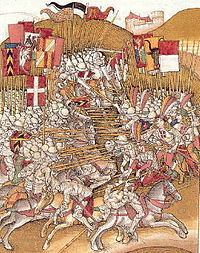unknown 1-1,500 | Date 21 June 1339 | |
 | ||
Result Bern Victory and tightening of Bern and Swiss confederate relationships resulting in Bern's permanent accession in 1353. Similar Battle of Sempach, Battle of Näfels, Battle of Morgarten, Burgundian Wars, Battle of St Jakob an der Birs | ||
The Battle of Laupen was fought on June 21, 1339 between Bern and its allies on one side, and Freiburg together with feudal landholders from the County of Burgundy and Habsburg territories on the other. Bern was victorious, consolidating its position in the region. As a consequence of the conflict, the relations of Bern and the Swiss Confederacy tightened, resulting in Bern's permanent accession in 1353.
Contents
This is also the first battle that the white cross was documented as being used as a field sign worn by Swiss combatants.
Background
Prior to hostilities the free imperial city of Bern had undergone heavy expansion, however this expansion came at high expense to the feudal lords in the area and led to increasing competition with the neighbouring city of Freiburg. Angered, the feudal lords, in league with Freiburg, created a combined force of 17,000 men, including 1000 feudal heavy cavalry under the command of Rudolf von Nidau and Gérard de Valengin. While the cavalry were a powerful force, much of the infantry, with the exception of the Freiburg contingent, were poorly equipped and unmotivated This force set out to confront Bern by besieging the border town of Laupen. To raise the siege, Bern raised a force of 6,000, consisting of Bernese, supported by Forest Cantons of Uri, Schwyz and Unterwalden (who had entered a military alliance with Bern in 1323), and other allies (Simmental, Weissenburg, Oberhasli).
The battle
The Bernese army marched to the relief of Laupen, arriving in the afternoon of 21st. June. Rather than attempt an attack on the Freiburger siege lines, they drew up their army on a hill called the Bramberg, 3 km. NE of Laupen, as a challenge to their enemies to come and fight. The formation of the Bernese consisted of one or more haufen, deep bodies of infantry. To one flank, probably the left, stood the troops of the Forest Cantons. The arrival of the Bernese was noted by the Freiburgers and they rapidly armed and arrayed themselves for battle. Late in the afternoon, they launched their attack.
The Freiburg force was led by their cavalry, followed by the larger body of infantry. An unknown number of troops were left in the siege camp, to protect the equipment and prevent a sally by the 600 strong Bernese garrison. The cavalry vanguard moved to threaten the Bernese, with a number of newly dubbed knights riding close to the Bernese lines waving their swords, but the Bernese force held its position. When the Freiburg infantry formed up, the cavalry launched an assault which brought them into contact with the Forest Canton contingent, who rapidly formed an all-round defensive formation known as a hedgehog (Igel). Away from this flank action, the Freiburger infantry advanced up the hill. The Bernese threw forward a screen of crossbowmen and stone-throwers to harass this advance but these quickly fell back as the Freiburgers closed. This seems to have caused a panic in the rear ranks of the Bernese army and a large number (up to 2000) men fled into the forest behind the Bramberg. Remarkably, the rest of the army held firm. The two infantry lines then clashed. Despite their numerical advantage, the Freiburgers were quickly broken and fled away towards Laupen, the flight being led by the feudal contingent from Vaud. The contingent from Freiburg suffered particularly heavily, losing their Burgomeister and the City standard bearer. Showing great control, a part of the Bernese army reordered itself and marched to relieve the Forest Cantons, who were still surrounded by the Freiburger's cavalry. The action here was possibly the fiercest of the day, with the horsemen now fighting on two fronts themselves. After a short bloody struggle, the cavalry were routed and suffered heavy casualties. At least 80 nobles fell, including the Counts of Nidau, Valengin and Aarburg and the son of Louis II of Vaud. The evening was now drawing on, which limited pursuit, but the Bernese forces marched into Laupen, where celebrations and services of thanksgiving for the victory were held.
Aftermath
The victory of the Bernese/Swiss against all odds, outnumbered two-to-one by an army containing such a force of mounted chivalry, came as a surprise, and chroniclers record that comments like "God himself must have become a Bernese citizen" were heard among the retreating Habsburg troops. Bern and Freiburg avoided further warfare. Bern was drawn into closer association with the Swiss Confederacy, becoming one of the Eight Cantons in 1353. Freiburg itself would become an associate of the Confederation in 1454 and a full member in 1481.
Wider significance
Comparable to the Battle of Bannockburn 25 years earlier, Laupen was one of a string of battles presaging the definite decline of High Medieval heavy cavalry (knights) in the face of improving infantry tactics during the following century.
The battle is also the first occasion for which use of the Swiss cross as a badge to identify confederate troops is attested; it was shown on combatants' clothing as two stripes of textile, contrasting with the red St. George's cross of Habsburg Austria, and with the Saint Andrew's cross later used by Burgundy and Maximilian I.
